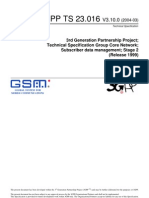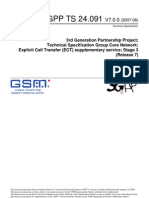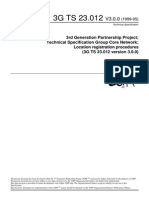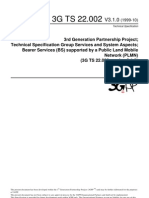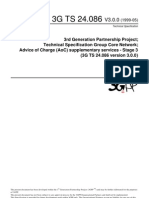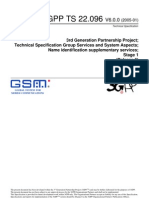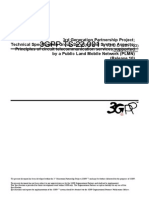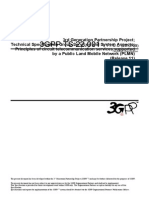3GPP TS 22.031
3GPP TS 22.031
Uploaded by
santanameroCopyright:
Available Formats
3GPP TS 22.031
3GPP TS 22.031
Uploaded by
santanameroOriginal Title
Copyright
Available Formats
Share this document
Did you find this document useful?
Is this content inappropriate?
Copyright:
Available Formats
3GPP TS 22.031
3GPP TS 22.031
Uploaded by
santanameroCopyright:
Available Formats
3GPP TS 22.031 V3.0.
0 (2002-12)
Technical Specification
3rd Generation Partnership Project; Technical Specification Group Services and System Aspects; 3G Security; Fraud Information Gathering System (FIGS); Service description - Stage 1 (Release 1999)
GLOBAL SYSTEM FOR MOBILE COMMUNICATIONS
The present document has been developed within the 3rd Generation Partnership Project (3GPP TM) and may be further elaborated for the purposes of 3GPP. The present document has not been subject to any approval process by the 3GPP Organisational Partners and shall not be implemented. This Specification is provided for future development work within 3GPP only. The Organisational Partners accept no liability for any use of this Specification. Specifications and reports for implementation of the 3GPP TM system should be obtained via the 3GPP Organisational Partners' Publications Offices.
Release 1999
3GPP TS 22.031 V3.0.0 (2002-12)
Keywords
3GPP, GSM, Security, Stage 1
3GPP Postal address
3GPP support office address
650 Route des Lucioles - Sophia Antipolis Valbonne - FRANCE Tel.: +33 4 92 94 42 00 Fax: +33 4 93 65 47 16
Internet
http://www.3gpp.org
Copyright Notification No part may be reproduced except as authorized by written permission. The copyright and the foregoing restriction extend to reproduction in all media.
2002, 3GPP Organizational Partners (ARIB, CWTS, ETSI, T1, TTA, TTC). All rights reserved.
3GPP
Release 1999
3GPP TS 22.031 V3.0.0 (2002-12)
Contents
Foreword ............................................................................................................................................................4 1 2 3
3.1 3.2
Scope ........................................................................................................................................................5 References ................................................................................................................................................5 Definitions and abbreviations...................................................................................................................5
Definitions............................................................................................................................................................... 5 Abbreviations .......................................................................................................................................................... 6
4
4.1 4.2 4.3
Fraud Information Gathering System high level requirements ................................................................6
Description .............................................................................................................................................................. 6 Applicability............................................................................................................................................................ 6 Normal Procedure.................................................................................................................................................... 6
5
5.1 5.2 5.3 5.4
Service conditions ....................................................................................................................................7
Control of monitoring of subscriber activities......................................................................................................... 7 Number of calls monitored by a VPLMN ............................................................................................................... 7 Interworking with non-supporting networks ........................................................................................................... 7 Information Delivery Time...................................................................................................................................... 8
6 7 8
Monitored activity ....................................................................................................................................8 Interface between HPLMN and FDS .......................................................................................................8 Security Requirements between HPLMN and VPLMN ..........................................................................8 Information transferred by the VPLMN.......................................................9 Message flow in FIGS monitoring, normal procedure ...............................11 Change history ...............................................................................................12
Annex A (normative): Annex B (normative): Annex C (informative):
3GPP
Release 1999
3GPP TS 22.031 V3.0.0 (2002-12)
Foreword
This Technical Specification has been produced by the 3rd Generation Partnership Project (3GPP). The contents of the present document are subject to continuing work within the TSG and may change following formal TSG approval. Should the TSG modify the contents of the present document, it will be re-released by the TSG with an identifying change of release date and an increase in version number as follows: Version x.y.z where: x the first digit: 1 presented to TSG for information; 2 presented to TSG for approval; 3 or greater indicates TSG approved document under change control. y the second digit is incremented for all changes of substance, i.e. technical enhancements, corrections, updates, etc. z the third digit is incremented when editorial only changes have been incorporated in the document.
3GPP
Release 1999
3GPP TS 22.031 V3.0.0 (2002-12)
Scope
The present document specifies the stage 1 description of the Fraud Information Gathering System (FIGS) feature which provides the means for the HPLMN to monitor the activities of its subscribers in a VPLMN. The purpose of this network feature is to enable the HPLMN to monitor the activities of its subscribers while they are roaming. The VPLMN collects information about a defined set of activities on monitored subscribers and sends this information back to the HPLMN. This enables the HPLMN to clear certain types of calls and so stop fraudulent use of the GSM system. The present document enables service providers/ network operators to use FIGS, and service limitation controls such as Operator Determined Barring (ODB) and Immediate Service Termination (IST), to limit their financial exposure to subscribers producing large unpaid bills. HPLMNs may also choose to monitor the activities of its subscribers within the HPLMN.
References
References are either specific (identified by date of publication, edition number, version number, etc.) or non-specific. For a specific reference, subsequent revisions do not apply. For a non-specific reference, the latest version applies. For this Release 1999 document, references to GSM documents are for Release 1999 versions (version 8.x.y). [1] [2] GSM 01.04: "Digital cellular telecommunications system (Phase 2+); Abbreviations and acronyms". GSM 02.33: "Digital cellular telecommunications system (Phase 2+); Lawful Interception - stage 1
The following documents contain provisions which, through reference in this text, constitute provisions of the present document.
3
3.1
Definitions and abbreviations
Definitions
For the purposes of the present document, the following terms and definitions apply: A subscriber: calling mobile subscriber. B subscriber: mobile subscriber originally called by the A subscriber C subscriber: subscriber to whom the B subscriber has requested that calls be forwarded. The C subscriber may be fixed or mobile call: both connection-oriented and connectionless services/events call information: information about a call call reference: reference number for a call that shall remain constant throughout the duration of that call and that shall be unique to that call and the switch on which the call was made for a period of at least one week home network: home PLMN including non-GSM elements such as the Fraud Detection System (FDS), customer service systems and billing
3GPP
Release 1999
3GPP TS 22.031 V3.0.0 (2002-12)
monitored activities: subscriber activities that shall be reported to the HPLMN. These can be call related events (e.g. call-set-up, call termination) or the invocation of call related and call independent supplementary services (e.g. Call Hold, Call Waiting, Call Transfer, Call Forwarding, Unstructured Supplementary Service Data)
3.2
CGI FDS FIGS IST MO MT
Abbreviations
Cell Global Identifier Fraud Detection System Fraud Information Gathering System Immediate Service Termination Mobile Originated Mobile Terminated
Abbreviations used in the present document are also listed in GSM 01.04 and the following apply:
4
4.1
Fraud Information Gathering System high level requirements
Description
It shall be possible for the HPLMN to request the VPLMN to supply certain information about a subscriber from the time the subscriber registers in that VPLMN to the time the last of the monitored activities is finished in that VPLMN, which can be after the subscribers de-registration from the VPLMN. The information received by the HPLMN shall be passed to the relevant network or service providers and used to instruct the VPLMN to act in an appropriate way. Fraud information gathering is controlled by the HPLMN and can be activated and deactivated by the HPLMN only. The information is received in the HPLMN and is forwarded to fraud detection and control systems. Such systems are out of the scope of this standard. The subscriber is specified by the IMSI or MSISDN.
4.2
Applicability
This network feature applies to all subscribed Bearer Services and Teleservices and supplementary services of the subscriber. It is not possible to apply FIGS independently to individual Services. The HPLMN shall be able to specify whether it would like call information on MO calls, MT calls, or both.
4.3
Normal Procedure
The HPLMN shall be able to request a VPLMN to monitor a subscriber. See annex A for the definition of the information to be sent for each call event. If the VPLMN cannot monitor the subscriber, it shall indicate this as a response to the FIGS request. The FDS will process this information and may then limit the activities of the subscriber using ODB or terminate the subscriber activities using IST, or may allow the subscriber to proceed. When the home network no longer wishes the subscriber to be monitored by the VPLMN it requests the VPLMN to stop monitoring the activities of the subscriber. Figure 1 shows the sequence of FIGS messages passed during a normal case.
3GPP
Release 1999
3GPP TS 22.031 V3.0.0 (2002-12)
5
5.1
Service conditions
Control of monitoring of subscriber activities
The HPLMN can request a VPLMN to begin monitoring the activities of a subscriber when the subscriber has registers on that VPLMN or at any time after registration. If the VPLMN is able to monitor a subscriber as requested it shall send a confirmation of monitoring message to the HPLMN. The HPLMN does not need to know the status of the target subscriber before initiation or subsequent termination of fraud information gathering. Fraud information cannot be switched on or off by the subscriber or other (unauthorised) party. Subscribers upon which fraud information gathering has been set shall not be able by interrogating the network to determine that they are subject to fraud information gathering. Subscribers upon which fraud information gathering has been set shall not be able, for example by significant changes to normal call set up times, speech quality or general transmission characteristics, to determine that they are subject to fraud information gathering. If the VPLMN receives a request to monitor the activities of a subscriber and an activity to be monitored is already ongoing it is not necessary for the VPLMN to send information on this particular activity to the HPLMN. If the VPLMN receives a request to cease monitoring the activities of a subscriber and an activity is already ongoing and being monitored, the VPLMN shall immediately cease sending information on this activity to the HPLMN.
5.2
Number of calls monitored by a VPLMN
If the VPLMN has to monitor the activities of a large number of subscribers for FIGS this may degrade the performance of the VPLMN. Each VPLMN (in reality, each network entity involved in FIGS monitoring) will therefore have a maximum number of subscribers that it can monitor. If the number of monitored subscribers has reached this upper limit the VPLMN shall reject requests for monitoring of subscribers from HPLMNs until the number of monitored subscribers decreases below the limit. Each VPLMN may have a limit per HPLMN on the number of subscribers from that HPLMN that it will monitor. When an HPLMN has requested a VPLMN to monitor a number of subscribers equal to the limit for that HPLMN, the VPLMN can refuse any subsequent requests for FIGS monitoring from that PLMN, until the number of monitored subscribers drops below the limit. The principles behind the setting of these limits are outside the scope of the present document. In order to minimise the number of subscribers that a VPLMN has to monitor, the HPLMN should ideally limit itself to requesting information about subscriber's monitored activities in: the current VPLMN; the last previously served VPLMN.
5.3
Interworking with non-supporting networks
If the HPLMN does not receive a positive acknowledgement to the request for FIGS monitoring sent to a VPLMN, it shall assume that the VPLMN does not support FIGS. The HPLMN may then act as appropriate (e.g. put appropriate ODB categories in place).
3GPP
Release 1999
3GPP TS 22.031 V3.0.0 (2002-12)
5.4
Information Delivery Time
The need for up to date information is a critical part of any fraud information system. The sooner data is transferred to the HPLMN, the sooner fraud can be stopped. Therefore the prescribed information shall be transferred from the VPLMN network to the HPLMN within two minutes of the occurrence of a FIGS-monitored event, if real time implementations of FIGS are used. The information should be transferred from the VPLMN to the HPLMN over appropriate communication links.
Monitored activity
The authorised party can request the VPLMN to monitor both call activity and supplementary services. The monitoring of call activity shall take the form of transmission of call information from the VPLMN to the HPLMN, at the start and end of all calls. For long calls, the VPLMN shall also send partial call information a certain time (e.g. 15 minutes) after the call has begun. Call information shall be sent to the HPLMN by the VPLMN on the invocation of all supplementary services, e.g.: call deflection; call forwarding; call hold; Multi Party (MPTYY); Explicit Call Transfer (ECT).
The HPLMN can decide to prevent future invocation of the same or all supplementary services using ODB. The decision mechanism is out of the scope of the present document.
Interface between HPLMN and FDS
Information gathered by the HPLMN may be transferred to Non-GSM systems, e.g. an FDS. These systems will decide if the monitored activity is fraudulent and will advise the home network to take appropriate action, e.g. send an IST command to the VPLMN, change the subscribers ODB categories. The contents of call information messages to be transferred on this interface shall be specified but not the transfer mechanism. This is in line with the approach used for the X-interface as specified in GSM 02.33. The message formats are defined in annex A. The system needs the ability to handle the volume of information returned to the home network.
Security Requirements between HPLMN and VPLMN
It is expected that there will be a need for authentication, data integrity and confidentiality of the communication made between PLMNs. These issues are for study under other work items within the SMG 10 work programme.
3GPP
Release 1999
3GPP TS 22.031 V3.0.0 (2002-12)
Annex A (normative): Information transferred by the VPLMN
The reports generated by the VPLMN shall take the form of "call information records for each monitored subscriber. The content of the call information will depend on the type of event (call start, end etc.). To simplify matters, there will be one format for both MO and MT calls with an MO/MT indicator within the call information to distinguish between the two. A partial call information will be sent to the HPLMN when there is an mid-call invocation of a supplementary service and when a call in progress has exceeded a defined duration. Justification is given for the content of the call information message. Table A.1: Call information content
Information Dialled digits A subscriber B subscriber C subscriber CGI IMSI IMEI Call Start Time/Date Call Duration Call Reference MO/MT indicator Visited MSC address Type of SS event Type of Basic Service
The Dialled digits are required as these are an important indicator in deciding if a call is fraudulent or not - certain call destinations are more likely to be called fraudulently than others. A subscriber can be used to identify the subscriber B, C subscriber are relevant as some call destinations are more subject to fraud than others. Cell Global Identifier (CGI) is relevant as some cells in a PLMN are more subject to fraud than others. The IMSI is used to reference the subscriber. The IMEI can be used to check if a stolen handset has been used. The Call Start Time/Date is required so that the call duration can be calculated (if the call end time and not call duration is given at call conclusion) and because the call start time can also an important indicator of fraudulency. The Call Duration gives the duration of the call at the sending of the partial call information - call duration can be an important indicator of fraudulency. If call end is sent instead, the duration can be calculated using the call start and end times. The Call Reference is used to reference a particular call. The MO/MT indicator is required because call charging is different for MO and MT calls. The Visited MSC address gives the PLMN on which the call was made. The Type of SS event record is sent if the call start is actually the invocation of a supplementary service, e.g. ECT. The Type of SS event is required as this can help to indicate if the mobile is being fraudulently used or not.
3GPP
Release 1999
10
3GPP TS 22.031 V3.0.0 (2002-12)
The Type of Basic Service indicates whether a teleservice or bearer service is being used and which sort of teleservice or bearer service is being used and is sent if the event is a call and not a supplementary service. The Type of Basic Service is required as this can help to indicate if the mobile station is being fraudulently used or not.
3GPP
Release 1999
11
3GPP TS 22.031 V3.0.0 (2002-12)
Annex B (normative): Message flow in FIGS monitoring, normal procedure
HPLMN
Request for FIGS monitoring
VPLMN
Positive Acknowledgement
FIGS Data
FIGS Data
Request to stop FIGS monitoring
Figure B.1: Message flow in FIGS monitoring, normal procedure
3GPP
Release 1999
12
3GPP TS 22.031 V3.0.0 (2002-12)
Annex C (informative): Change history
Change history GSM 02.31
Date 06-1997 10-1997 10-1997 03-1998 06-1998 08-1999 04-2000 06-2001 Date 12-2002 TSG # SMG#22 SMG#23 SMG#23 SMG#25 SMG#26 A001 1 TSG Doc. CR Rev Subject/Comment Old New 1.0.0 2.0.0 5.0.0 7.0.0 7.1.0 7.1.1 8.0.0 8.0.1
No Phase 1 version
To SMG#22 for information To SMG#23 for approval TS approved by SMG#23 2.0.0 The specification was converted to version 7.0.0 because the work 5.0.0 item is related to Release 98; version 5.0.0 withdrawn. (SMG#25) 7.0.0 CR 02.31-A001r1 (correction) approved by SMG#26 Publication version 7.1.0 Release 1999 publication version 7.1.1 ETSI Publication 8.0.0
Change history 3GPP TS 22.031
TSG # SA#18 TSG Doc. CR Rev Subject/Comment Agreed to convert to 3GPP/GSM joint numbering scheme. 02.31 WITHDRAWN. Technically equivalent to 0231 version 8.0.1 Old New 02.31 22.031 v8.0.1 v3.0.0
3GPP
You might also like
- 3GPP TS 22.031Document12 pages3GPP TS 22.031santanameroNo ratings yet
- 3GPP TS 22.031Document12 pages3GPP TS 22.031santanameroNo ratings yet
- 3GPP TS 22.032Document8 pages3GPP TS 22.032santanameroNo ratings yet
- 3GPP TS 23.011Document24 pages3GPP TS 23.011santanameroNo ratings yet
- 3GPP TS 22.041Document10 pages3GPP TS 22.041santanameroNo ratings yet
- 3GPP TS 22.041Document10 pages3GPP TS 22.041santanameroNo ratings yet
- IR.81-V3.0 - GRQ Measurement ImplementationDocument46 pagesIR.81-V3.0 - GRQ Measurement Implementationa_big_friendNo ratings yet
- 3GPP TS 23.035Document11 pages3GPP TS 23.035santanameroNo ratings yet
- 3GPP TS 22.115Document13 pages3GPP TS 22.115santanameroNo ratings yet
- 3rd Generation Partnership Project Technical Specification Group Core Network Line Identification Supplementary Services - Stage 3 (3G TS 24.081 Version 3.0.0)Document13 pages3rd Generation Partnership Project Technical Specification Group Core Network Line Identification Supplementary Services - Stage 3 (3G TS 24.081 Version 3.0.0)santanameroNo ratings yet
- 3GPP TS 23.016Document30 pages3GPP TS 23.016santanameroNo ratings yet
- 3GPP TS 24.091Document11 pages3GPP TS 24.091santanameroNo ratings yet
- 3GPP TS 24.091Document11 pages3GPP TS 24.091santanameroNo ratings yet
- 3GPP TS 23.016Document29 pages3GPP TS 23.016santanameroNo ratings yet
- 3rd Generation Partnership Project Technical Specification Group Core Network Location Registration Procedures (3G TS 23.012 Version 3.0.0)Document10 pages3rd Generation Partnership Project Technical Specification Group Core Network Location Registration Procedures (3G TS 23.012 Version 3.0.0)santanameroNo ratings yet
- Taller Roaming PP Fraude EngDocument0 pagesTaller Roaming PP Fraude Enghalcon2001No ratings yet
- 3GPP TS 23.016Document31 pages3GPP TS 23.016santanameroNo ratings yet
- 3rd Generation Partnership Project Technical Specification Group Core Network Multi Party (MPTY) Supplementary Service - Stage 3 (3G TS 24.084 Version 3.0.0)Document14 pages3rd Generation Partnership Project Technical Specification Group Core Network Multi Party (MPTY) Supplementary Service - Stage 3 (3G TS 24.084 Version 3.0.0)santanameroNo ratings yet
- 3GPP TS 22.153Document9 pages3GPP TS 22.153santanameroNo ratings yet
- 3rd Generation Partnership Project Technical Specification Group Core Network Line Identification Supplementary Services - Stage 3 (Release 99)Document12 pages3rd Generation Partnership Project Technical Specification Group Core Network Line Identification Supplementary Services - Stage 3 (Release 99)santanameroNo ratings yet
- 300Document48 pages300santanameroNo ratings yet
- 3GPP TS 22.011 V8.4.1 - Technical Specification Group Services and System Aspects, Service AcessibilityDocument25 pages3GPP TS 22.011 V8.4.1 - Technical Specification Group Services and System Aspects, Service AcessibilityRaissa BailloNo ratings yet
- 3rd Generation Partnership Project Technical Specification Group Services and System Aspects Service Aspects Charging and Billing (3G TS 22.105 Version 3.1.0)Document14 pages3rd Generation Partnership Project Technical Specification Group Services and System Aspects Service Aspects Charging and Billing (3G TS 22.105 Version 3.1.0)santanameroNo ratings yet
- TD.58 v2.4Document64 pagesTD.58 v2.4PopaProstu100% (2)
- IR 81-v4 0 PDFDocument79 pagesIR 81-v4 0 PDFAndi MahardikaNo ratings yet
- 3rd Generation Partnership Project Technical Specification Group Core Network Unstructured Supplementary Service Data (USSD) - Stage 2 (3G TS 23.090 Version 3.0.0)Document38 pages3rd Generation Partnership Project Technical Specification Group Core Network Unstructured Supplementary Service Data (USSD) - Stage 2 (3G TS 23.090 Version 3.0.0)Ajay ChhalotreNo ratings yet
- 3rd Generation Partnership Project Technical Specification Group Services and System Aspects Bearer Services (BS) Supported by A Public Land Mobile Network (PLMN) (3G TS 22.002 Version 3.1.0)Document13 pages3rd Generation Partnership Project Technical Specification Group Services and System Aspects Bearer Services (BS) Supported by A Public Land Mobile Network (PLMN) (3G TS 22.002 Version 3.1.0)santanameroNo ratings yet
- 3GPP TS 22.090Document9 pages3GPP TS 22.090santanameroNo ratings yet
- 3rd Generation Partnership Project Technical Specification Group Services and System Aspects Service Aspects Charging and Billing (Release 1999)Document14 pages3rd Generation Partnership Project Technical Specification Group Services and System Aspects Service Aspects Charging and Billing (Release 1999)santanameroNo ratings yet
- 3GPP TS 23.084Document29 pages3GPP TS 23.084santanameroNo ratings yet
- 3GPP TS 22.002Document12 pages3GPP TS 22.002santanameroNo ratings yet
- 3Rd Generation Partnership Project Technical Specification Group Core Network Advice of Charge (Aoc) Supplementary Services - Stage 3 (3G Ts 24.086 Version 3.0.0)Document12 pages3Rd Generation Partnership Project Technical Specification Group Core Network Advice of Charge (Aoc) Supplementary Services - Stage 3 (3G Ts 24.086 Version 3.0.0)santanameroNo ratings yet
- 3GPP TS 24.083Document16 pages3GPP TS 24.083santanameroNo ratings yet
- 300Document18 pages300santanameroNo ratings yet
- 3GPP TS 22.090Document9 pages3GPP TS 22.090santanameroNo ratings yet
- 3rd Generation Partnership Project Technical Specification Group Core Network Multicall Supplementary Service - Stage 3 (Release 1999)Document14 pages3rd Generation Partnership Project Technical Specification Group Core Network Multicall Supplementary Service - Stage 3 (Release 1999)unal1No ratings yet
- 3GPP TS 22.090Document9 pages3GPP TS 22.090santanameroNo ratings yet
- 3GPP TS 24.084Document13 pages3GPP TS 24.084santanameroNo ratings yet
- Gsmts 0315v050100pDocument19 pagesGsmts 0315v050100pDario AlfaroNo ratings yet
- 3GPP TS 24.083Document16 pages3GPP TS 24.083santanameroNo ratings yet
- 3GPP TS 22.041Document12 pages3GPP TS 22.041Ahmad Mustafa AtharNo ratings yet
- 3rd Generation Partnership Project Technical Specification Group Core Network Explicit Call Transfer (ECT) Supplementary Service - Stage 3 (3G TS 24.091 Version 3.0.0)Document12 pages3rd Generation Partnership Project Technical Specification Group Core Network Explicit Call Transfer (ECT) Supplementary Service - Stage 3 (3G TS 24.091 Version 3.0.0)santanameroNo ratings yet
- 3GPP TS 22.001: Technical SpecificationDocument27 pages3GPP TS 22.001: Technical SpecificationsantanameroNo ratings yet
- 3GPP TS 22.096Document10 pages3GPP TS 22.096santanameroNo ratings yet
- 3rd Generation Partnership Project Technical Specification Group Core Network Call Deflection (CD) Supplementary Service - Stage 3 (3G TS 24.072 Version 3.0.0)Document9 pages3rd Generation Partnership Project Technical Specification Group Core Network Call Deflection (CD) Supplementary Service - Stage 3 (3G TS 24.072 Version 3.0.0)santanameroNo ratings yet
- TD.58 v2.3Document64 pagesTD.58 v2.3Gustavo Adolfo AcaNo ratings yet
- 3GPP TS 24.135Document14 pages3GPP TS 24.135santanameroNo ratings yet
- 3GPP TS 22.002Document12 pages3GPP TS 22.002santanameroNo ratings yet
- 3GPP TS 23.101Document14 pages3GPP TS 23.101srmanoharaNo ratings yet
- 3rd Generation Partnership Project Technical Specification Group Services and System Aspects Service Accessibility (Release 1999)Document14 pages3rd Generation Partnership Project Technical Specification Group Services and System Aspects Service Accessibility (Release 1999)santanameroNo ratings yet
- 3GPP TS 24.088Document16 pages3GPP TS 24.088santanameroNo ratings yet
- 3GPP TS 24.002Document11 pages3GPP TS 24.002santanameroNo ratings yet
- 3GPP TS 22.076Document10 pages3GPP TS 22.076santanameroNo ratings yet
- 3GPP TS 22.076Document10 pages3GPP TS 22.076santanameroNo ratings yet
- 3GPP TS 24.085Document10 pages3GPP TS 24.085santanameroNo ratings yet
- 3GPP TS 24.002Document11 pages3GPP TS 24.002santanameroNo ratings yet
- 23.292 v020 CleanDocument11 pages23.292 v020 CleankiafiveNo ratings yet
- 3GPP TR 22.868Document15 pages3GPP TR 22.868santanameroNo ratings yet
- UMTS and Data Services - 1st Quarter 2008: Total Market Unidade 1Q07 2Q07 3Q07 4Q07 1Q08Document6 pagesUMTS and Data Services - 1st Quarter 2008: Total Market Unidade 1Q07 2Q07 3Q07 4Q07 1Q08anujgujjarNo ratings yet
- 3GPP TS 22.001: Technical SpecificationDocument27 pages3GPP TS 22.001: Technical SpecificationsantanameroNo ratings yet
- 3GPP TS 22.001: Technical SpecificationDocument27 pages3GPP TS 22.001: Technical SpecificationsantanameroNo ratings yet
- 3GPP TS 22.001: Technical SpecificationDocument27 pages3GPP TS 22.001: Technical SpecificationsantanameroNo ratings yet
- 3GPP TS 22.001: Technical SpecificationDocument27 pages3GPP TS 22.001: Technical SpecificationsantanameroNo ratings yet
- 3GPP TS 22.001: Technical SpecificationDocument27 pages3GPP TS 22.001: Technical SpecificationsantanameroNo ratings yet
- 3GPP TS 22.001: Technical SpecificationDocument27 pages3GPP TS 22.001: Technical SpecificationsantanameroNo ratings yet
- 3GPP TS 22.001: Technical SpecificationDocument27 pages3GPP TS 22.001: Technical SpecificationsantanameroNo ratings yet










